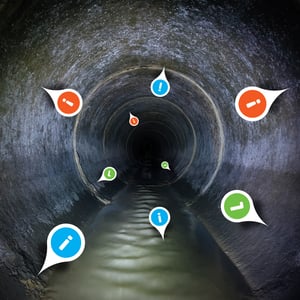Artificial intelligence is spreading across every area of our lives, from ride-sharing apps to spam filters to smart personal assistants. In the last few years, artificial intelligence (AI) has also seeped into the wastewater industry in the form of automated defect coding. AI promises major benefits over traditional operator inspection, mostly in the form of lower error rates and faster inspection times.
AI solutions for the sewer industry typically fall into one of two categories: an in-field assistant or an office-based coder. An in-field assistant is software working alongside camera operators in the field to identify possible defects. During an inspection, the software identifies an area of pipe that may contain a defect and, in some cases, provides coding suggestions. But it’s on the operator to make the final decision which defect code to use.
 In contrast, an office-based coder does all the coding for you. After a CCTV inspection is complete, footage is loaded into the software and automatically coded without any human input.
In contrast, an office-based coder does all the coding for you. After a CCTV inspection is complete, footage is loaded into the software and automatically coded without any human input.
The Challenge with AI
AI is a developing technology, and that means that both programmers and users are learning as they go. The biggest challenge for successful AI implementation in defect coding is inaccuracy, which may lead managers to make decisions and expend resources based on faulty information.
Machines learn much as human operators do: by reviewing examples and learning to recognize defects. AI “training” involves feeding data, in this case video and accurate defect coding, into the software. It can be a lengthy process, however. Industry experts like Mike Russin, general manager of WinCan, estimate that most existing AI technologies will require a minimum of 1 million feet of inspection footage to ensure accuracy. One company developing automatic defect coding is using over 4 million feet of HD side-scan inspection footage to train its system.
Comprehensive training for AI software is essential to ensuring accurate, PACP-compliant code. Inadequately trained software will make mistakes, confusing small roots for cracks, holes for taps, and cracks for fractures. Under-coding a defect, marking it as less severe than it is, means serious issues may go ignored. Over-coding, marking a minor defect as more severe, means defects that don’t need immediate repair may clutter the top of the to-do list.
How to Get The Most from AI
Utilities considering an investment in AI should make sure to ask the right questions about the development process and understand what it can—and can’t—accomplish.
For example, developing strong AI requires millions of feet of inspection footage. When receiving demonstrations on AI systems, gather a few pieces of information from the sales rep.
- How many feet of footage were used to train the AI?
- Was the data quality controlled by a human?
- What was the error rate prior to the quality control check?
If the software designers have invested the time and resources necessary to create reliable defect coding, they should be able to answer these questions satisfactorily.
Get Ready for AI
As with many new technologies entering the water and wastewater industry, operators are right to be discerning about AI. Sometimes, in their excitement, companies rush new tech to market before it’s ready. Others engage in less scrupulous selling by over-hyping the capabilities of their technology, and then leaving communities and contractors to pay for the mess. But artificial intelligence is coming, and it has the power to transform the industry.
To take advantage of the coming AI, explore all the options. Ask questions, and perform a few trial runs to get a feel for how it works in your own system. And when you’re confident in the technology, you can put it to work increasing efficiency and improving accuracy.
Investing in new inspection technologies is an important step towards further improving inspection productivity. Side-scan cameras offer high-definition images and faster inspection times. Read our white paper to learn more.

